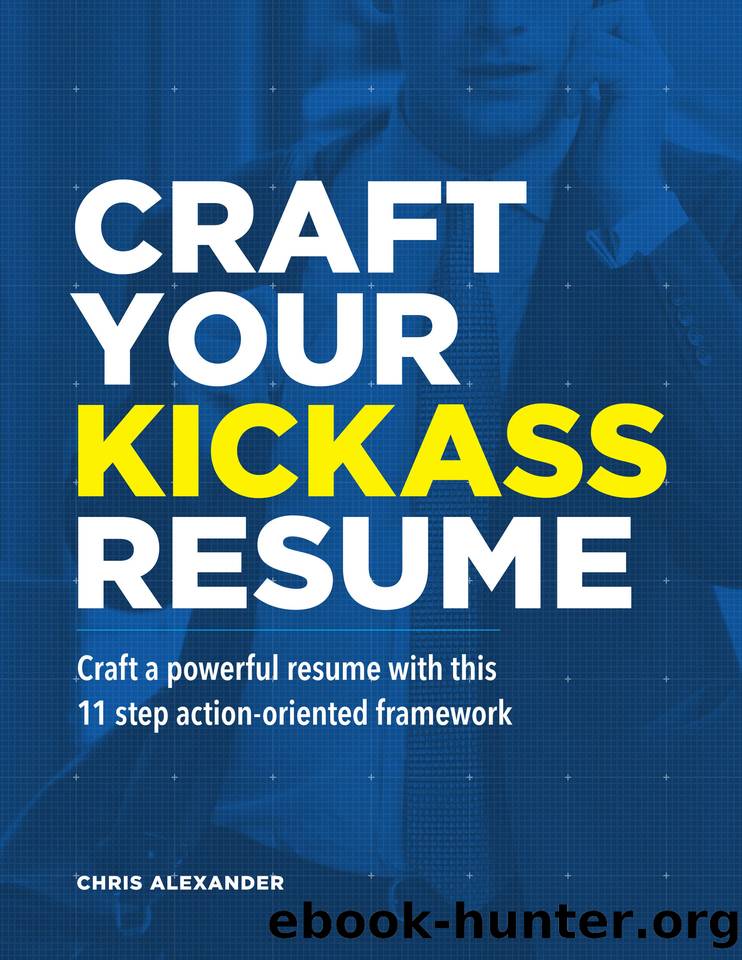Craft Your Kickass Resume: Craft a powerful resume with this 11 step action-oriented framework by Alexander Chris & Alexander Chris

Author:Alexander, Chris & Alexander, Chris [Alexander, Chris]
Language: eng
Format: epub
Published: 2020-12-31T16:00:00+00:00
DESIGN PRINCIPLES: UNDERSTANDING COGNITIVE LOAD
During the next 3 lessons, weâll focus on maximizing the impact of our resumeâs message. The parts are as follows:
â Understanding âCognitive Loadâ
â Choosing typefaces and fonts
â Using crystal clear headers and visual ratios
You may be looking at this list and asking yourself, What? What happened to all the talk about our stories, shaping our experiences, trying to cater to the needs of employers? Why all of a sudden are we going to talk about headers and typefaces? Surely these things only have to do with the look of the resume, not the message. Well, remember back in Lesson 1 where we said that a resume is just like deciding on where to meet up for a second date? That it was something to get the conversation starting between you and an employer? That it was, after all, an effort in communication? Well, it turns out how you look also important is getting across your message. And good design helps with exactly this.
All set? Okay, letâs do this!
In Lesson 2 we learned that our resume has 6 seconds to impress a hiring manager and escape the horrible maw of the shred bin. Letâs look a little more deeply into that time period and imagine what goes on. Most people, when they conjure up an image of the person reading their resume, come up with something like the following scene:
Itâs a sunny Monday morning. After getting 8.5 hours of uninterrupted sleep, an executive sits at her desk with a stack of resumes beside her and a fresh cup of coffee. Her office is absent of sounds or distractions - itâs quite simply the perfect environment for settling in and getting ready for some quiet reading⦠But waitâthatâs not reality. Not by a long shot! In reality, hiring managers read resumes in just about every kind of chaotic, messy scenario you can imagine, such as:
â Commuting on the train with jumbled resumes in hand
â On their phone, flipping through PDFâs while waiting for a soy latte
â During lunch while eating a burrito
â After lunch while digesting that burrito
â While on hold during an important personal call
â Sitting on their apartment floor with a gin and tonic in hand
In short, hiring managers are normal people who lead imperfect lives. What does it mean for us? We need to design our resume assuming our hiring manager will be distracted, stressed and worried about other more important things. In technical terms, we need to reduce the cognitive load involved in reading our resume.
âCognitive load?â you ask. What on earth is âcognitive load?!?â Itâs simply the amount of brainpower involved in a given activity. For a simple comparison, we can imagine all tasks we encounter throughout our day requiring a level of brainpower between 1 and 100. Completing a New York Times Crossword puzzle or doing your taxes might require a cognitive load of around 90. Stopping our car at a red light or brushing your teeth might require a cognitive load closer to 5.
Download
This site does not store any files on its server. We only index and link to content provided by other sites. Please contact the content providers to delete copyright contents if any and email us, we'll remove relevant links or contents immediately.
| Business School Guides | GMAT |
| Guides | Interviewing |
| Job Hunting | Job Markets & Advice |
| Resumes | Vocational Guidance |
| Volunteer Work |
The Motivation Myth by Jeff Haden(4967)
Audition by Ryu Murakami(4583)
Adulting by Kelly Williams Brown(4198)
The Confidence Code by Katty Kay(3996)
Waiting in the Wings by Melissa Brayden(3100)
A Mind For Numbers: How to Excel at Math and Science (Even If You Flunked Algebra) by Barbara Oakley(3081)
Self-Esteem by Matthew McKay & Patrick Fanning(2927)
Nice Girls Don't Get the Corner Office by Lois P. Frankel(2913)
The ONE Thing by Gary Keller(2894)
Fooled by Randomness: The Hidden Role of Chance in Life and in the Markets by Nassim Nicholas Taleb(2837)
The Dictionary of Body Language by Joe Navarro(2792)
How to be More Interesting by Edward De Bono(2644)
Designing Your Life by Bill Burnett(2581)
Getting Things Done by David Allen(2565)
The Plant Paradox by Dr. Steven R. Gundry M.D(2394)
Police Exams Prep 2018-2019 by Kaplan Test Prep(2335)
What Color Is Your Parachute? 2015 by Richard N. Bolles(2190)
Dangerous Personalities by Joe Navarro(2163)
When to Jump by Mike Lewis(2037)
